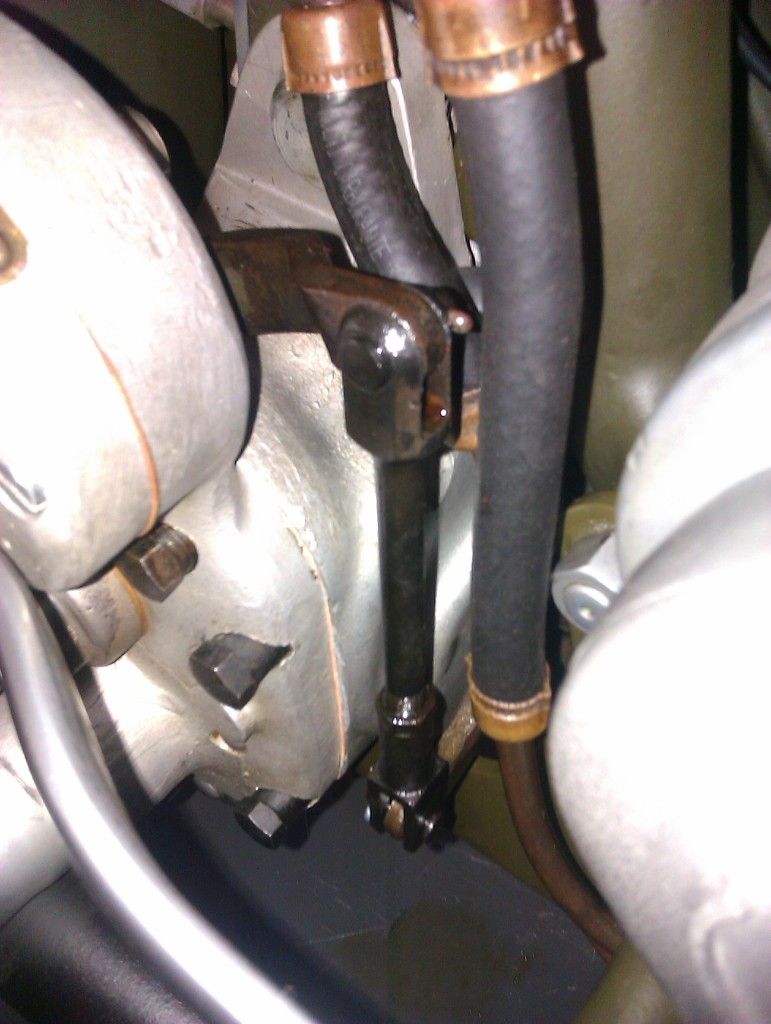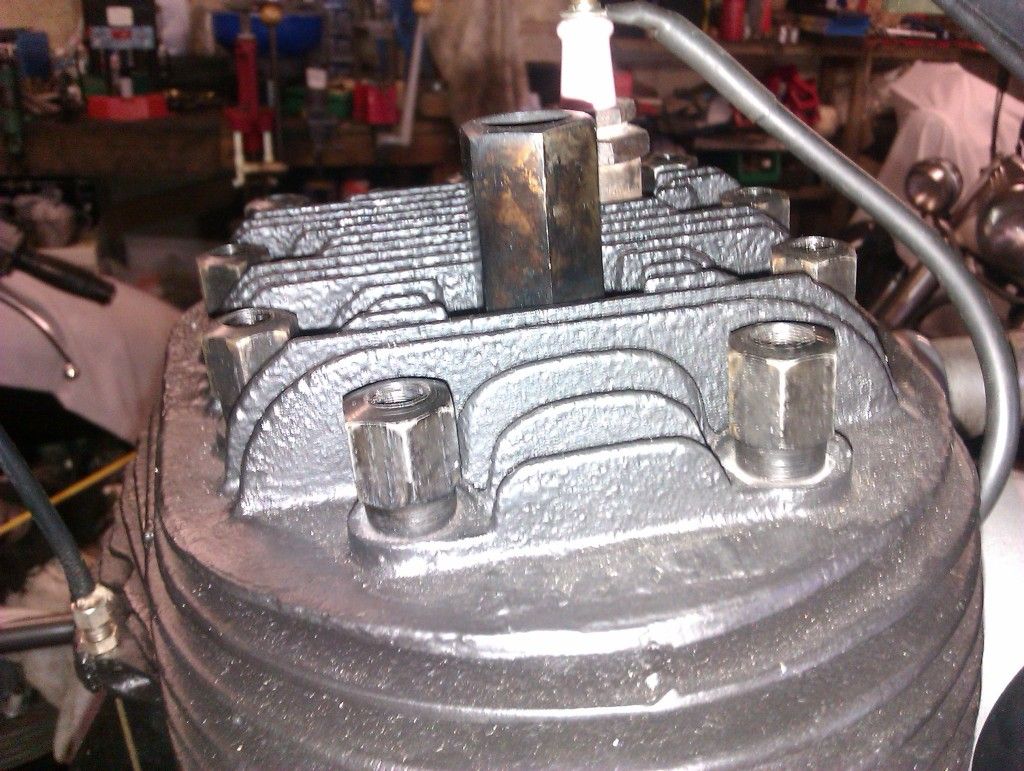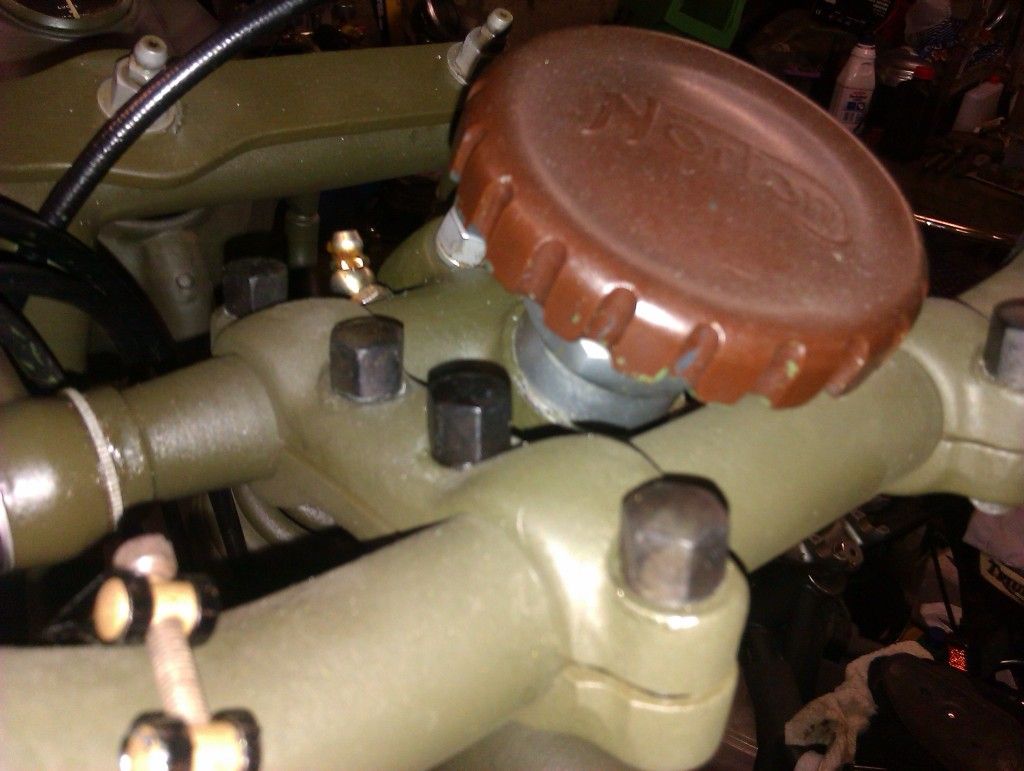On my bike all the nuts and bolts were originally blackened, I've seen allot of bikes that seem to be finished with nuts and bolts in a polished or zinc plated finish, but has anyone got any experience of a finish called Blackfast or is therr any other methods used for restoring the nuts and bolts back to a new black even finish.
email (option): 79aust@sky.com
The black finish used on military bolts was the same as used on gun barrels.
It is a phosphorous based treatment, usually done in a salt bath.
Trade names like "Parkerizing" or "Phosphating".
Any heat treater or gun smith will be able to do it to your bolts but only if they are bare steel.
Just like on a rifle, once on your bike they will need to be oiled fairly regularly to stop them rusting
email (option): wariron@tpg.com.au
I first degrease nuts and bolts, and any steel parts that need some rust-proofing, then a fine grit or glass bead blasting. Bolts are put in wood blocks to protect the thread. Then a 5 to 10% phosphoric acid bath, till they are dark grey, dry and either apply a clear rattle can varnish (for automotive use) or WD40. Not as good as professionally applied Parkerizing, but sufficient for me
email (option): viaconsu [at] planet [dot] nl
I always use Birchwood Casey Perma Blue for blueing gun parts with. You degrease the metal, just paint the gloop on and wipe it off when you think it's dark enough, the longer you leave it the blacker the metal goes.
just seen the Birchwood Casey Perma Blue and also seen Caswell Cold Black Oxide Kit, both seem very affordable and viable to DIY.
thanks for your help.
email (option): 79aust@sky.com
Caswell sell a black oxide kit for small shops that works quite well. See http://www.caswelleurope.co.uk/coldox.htm This URL is for the European subsidiary. They are a US company that sell a wide range of plating and other metal finishing kits.
My only issue with the Caswell process is the residual odor of the final pickeling solution that contains Stoddard's solvent.
Jeff
email (option): jjbandoo@aol.com
The only trouble I've found with the Birchwood Casey Perma Blue is that it also blacks your fingers very nicley too! Just be careful or you'll have black hands for about three days. Also, remember to shake the tube well before each coating as it tends to settle and separate and you can end up with a streaky finish if you've not given it a damn good rattle first. 
You can also do oil blacking which is very easy to do. I don't know how permanent it is but the finish is exactly the same as the original finish on my Norton.
I wrapped copper wire around the bolt and heated it up with a blow lamp until red hot. Then quench it in a tub of old engine oil. Lots of smoke and flame so do it outside. As the bolt comes out of the oil I keep the lamp on it and burn off the oil. It looks really good and identical to the original parts, some of which I left as they were.
I took the grease off the new old stock head nuts, only to find they were bare metal. That is not paint on them but oil blacking.




email (option): horror@blueyonder.co.uk
Yes, old fashioned oil blackening is another option and it's cheaper and it's great fun into the bargain! The first time I did it, it burst into flames and I nearly burned the shed down, needless to say, I now do it out on the back lawn when the wife is out 
Great result with the oil blacking, may give it a go first on not so visible bolts.
I hope I can keep the garage in tact after use, lol.
email (option): 79aust@sky.com
If you heat the bolts until they are pretty hot (dull red) with a blowlamp, then immerse them in dirty engine oil it takes on a very acceptable black finish that is fairly rust resilient but they do need the occasional wipe with an oily rag. If the oil ignites when you put the bolt in, simply remove it and it will go out, then re-immerse it. I use this trick a lot and it works well. just make sure that the bolt is cleaned up first with a wire brush or blasting before you do it, if you don't have a blow lamp simply hold it with a pair of pliers over a gas ring on the cooker for a while, but they really do need to get pretty hot. If needs be you can re-do it for a darker finish or re do if the bolt becomes rusty again
email (option): davmax@ntlworld.com
I didn't read your bit Ron, which is exactly the same as my post. Doh!
email (option): davmax@ntlworld.com
No Dave I posted after you. But just confirmed with a picture. Ron
Ron
email (option): ronpier@talk21.com
The M20 didn't have all that many 'blacked' fasteners. Remember this was a cheap and very temporary treatment and you can expect it to rust fairly rapidly once the bike is in use...and very rapidly if you use it on salted roads in the Winter or early Spring.
Personally I wouldn't use it unless I were embarked on a 'concours' restoration or the bike was going to be unused in a collection...but then I don't like rusty fasteners...Ian
email (option): ian@wright52.plus.com
I've seen so many restorations that have used new nickel or zinc plated fasteners that I wonder if they have changed all to metric or English threads?
I wish to ride this bike when complete in th Uk, therefore bright fasteners would be acceptable if I can source all.
email (option): 79aust@sky.com
You can get all your BSC, BSF, UNF and metric zink plated fasteners quite cheaply here. They are English made and plated.
http://www.nookysnuts.com/
Ron
email (option): ronpier@talk21.com
Some of the parts I oil blacked I'd already sent to the platers to be dull chromed. I only realised they should be black after. 
But the head nuts etc were bare metal and missed being sent off. When I looked at the WD motorcycle training film it showed the Norton with black head nuts, so black it was. If it starts to rust I'll spray them.
email (option): horror@blueyonder.co.uk
Yes Dave. Enfield's also seem to use quite a bit of chemical black as opposed to plating. Ron
email (option): ronpier@talk21.com
A company in Oldham, Frost Restoration, sell a plating kit for nickel plating parts.
http://www.frost.co.uk/automotive-electroplating.html
It is easy enough to do and cheap enough to set up with the bonus that you can make sure that the coating is a good one by leaving it in a little bit longer.
They also do a chemical blacking kit, but I have not used it so cannot comment on how good or otherwise it is.
http://www.frost.co.uk/coatings/chemical-blacking.html
Happy days
Darren
email (option): dwrudd at lineone.net
A UK company called Gateros Plating sells all kind of plating kits. Theit zinc plating kit is fine and you can buy a black passivate to finish the bolt in black. I have used their regular kit but not the black passivate but I guees it would work the same als the blue passivate I normally use.
Regards,
Leon
link
email (option): leonhop3@planet.nl
I've got one of these home plating kits for nickle. It's terrific for small parts like nuts, bolts, levers and so on, well worth the money, but I've never had much success with anything bigger than that. I never seem to get an consistant finnish on big things, even with new nickle and fresh salts. The most annoying thing I attempted was the nickle plated hubs on my WW1 Douglas. They looked great at the time, but after just 8 months sat in a dry garage, the nickle has started to peel away, so its now either paint them black or tear both wheels to bits again and get them professionally nickled? 
Red hot and then quenched in oil? Doesn't that increase brittleness? Don't you have to temper it afterwards? Especially if you do it multiple times.
email (option): jonny.rudge@verizon.net
Quite...you can't just do what you feel like to high carbon or heat treated steels without some consequences. The exact results will depend on the original state (at a molecular level) of the material, the temperature applied and the oil type and oil temperature that the part is quenched in. With unknown material and treatment specifications and an uncontrolled heating/ quenching process it's very much a game of 'russian roulette'..I would be more inclined to use gun black to achieve the finish which does not carry the same potential risks... ...Ian
email (option): ian@wright52.plus.com
True Ian, but we're talking nuts here, you fit them, once tightened the threads tend not to fall off! The same could be said for chrome plating which can cause hydrogen embrittlement even when carefully controlled. I'm not advocating anything that structual be done with this method, but none of the ones I've done seem to have suffered any problems.
email (option): davmax@ntlworld.com
Any plating process that can cause embrittlement should be followed by the heat treatment process that nullifies that effect...However, many platers only do it if you ask for it...I have bought zinc plated M20 head bolts that snapped like carrots at normal torque values...However, that is another subject.
As I said I wouldn't advise repeated heating and quenching of any component that may be made from a high carbon steel or has been heat treated.
Consider, for example, the effects if you were to do that to the end of a clutch pushrod which has been carefully hardened and tempered...Fork spindles, wheel spindles, small springs and high tensile bolts etc. are all similar examples which you might decide to finish in this way and which may be adversly affected by such methods....Ian
email (option): ian@wright52.plus.com
Hydrogen embrittlement is usually a problem only with high strength steel, not mild steel. I don't think there is any part that's made of high strength steel on M20s or, for that matter, any other mass-manufactured motorcycle, but I don't know for sure.
email (option): jonny.rudge@verizon.net
You're right Ian, I wouldn't heat up a wheel spindle to red hot or any other spindle. You wouldn't do it to a clutch rod, there'd be no point as you can't see it anyway. It is purely a finish for non stressed parts and I've only done it to the parts that were originally finished that way. I've checked on my ES2 and the gear linkage is blacked the same way as far as I can tell. It costs nothing to do and can easily be done again if needed.
email (option): horror@blueyonder.co.uk
There isn't any high strength (low alloy) steel on an M20 as it was not developed until the 1960s..However, this term should not he confused with high carbon steels which have a higher strength than mild steel but are completely different to HS steels.... What there is on an M20 is mild steel and high carbon steel.
Mild steel cannot be heat treated to alter characteristics such as hardness for example and subjecting such steels to 'blacking' by heating and quenching will have no effect but to alter the colour.
High carbon steels (which have varying amounts of carbon and other elements) can be subjected to a wide variety of heat treatment processes to alter the characteristics of the steel for different applications. Surface hardness, yield strength, ductility etc. can all be altered in this way.
High carbon steels can found in abundance on an M20..the example of the clutch pushrod being just one example. Many engine components and cycle parts are manufactured from heat treated high carbon steels...in fact anything you can find on the bike that has been hardened and other components where the effects might not be so obvious..for example springs, or where the material has been treated to improve surface wear characteristics or tensile strength etc. (as opposed to hardness).
Any high carbon steel if heated and rapidly quenched will become harder and more brittle and if a tempering process is not carried out will remain in that state...If heated and cooled slowly the reverse is likely to be the case...it will get softer and weaker.
Regarding hydrogen embrittlement during plating and other processes high carbon steels are particularly susceptible to this condition...thus the snapping cylinder head bolts I mentioned in my previous post, and such components should be treated after plating to reverse the process..
I'll say it again...if you are unsure whether a part is mild steel or high carbon steel it would be best to err on the side of safety and use a blacking solution such as those used for guns or a professionally applied chemical blacking process suited to the material rather than applying an uncontrolled quenching process which is likely to either seriously weaken such components or change their characteristics from those intended by the manufacturer..Ian

email (option): ian@wright52.plus.com
I should have been more specific and said mild steel cannot be hardened by heating and quenching processes..It can have it's surface hardness altered by the introduction of additional carbon at the surface...carburising..which is a heat treatment process but not based on heating and quenching to harden and temper the material... .Ian
email (option): ian@wright52.plus.com
Actually no.
Oil quenching is far, far, far less severe than water quenching and is in fact used to prevent embrittlement.
Molecules go from a high energy to a low energy so you get no diffussion of carbon from the oil into the iron untill the oil gets to be hotter than the iron.
email (option): wariron@tpg.com.au
Actually no (2)...High carbon steels already have carbon above a specified level in them, and this is what makes them hardenable. The process of hardening and tempering is carried out to produce the desired characteristics in the final product to suit given applications. When the steel is heated its internal form alters. It is first hardened by being heated to the Austenitic temperature range (which varies for different steel alloys) and then rapidly quenched..This produces a hard but brittle component.(Martensite)
Tempering involves heating the component again but to a lower temperature and then requenching...What that temperature is and the various aspects of the quenching process after this second reheating determine the characteristics of the resulting material.
Water, salt water and oil allow for variable rates of cooling and varying degrees of hardness after the process is completed, as depending which method is used (and the nature of the steel alloy used initially) there will be different internal molecular structures within the steel. Another reason for controlling quenching times is to reduce the risk of cracking in components of a large cross section, where shrinkage of the outer surface occurs too quickly.
NO carbon is absorbed from the quenching process...
What happens to a component made from a high carbon steel if it is randomly heated and quenched depends on three factors...1) its original state 2) the temperature it is heated to 3)the type and duration of quenching.
Depending on these three factors the part could end up either harder and more brittle than it was originally or softer and less brittle than it was originally and it should be regarded as a completely unpredictable process..and therefore not advisable. In the case of mild steel (or plain carbon steel by its other name) the situation is completely different...as it also is with the hydrogen embrittlement that occurs during plating, which was also mentioned....Ian
email (option): ian@wright52.plus.com
Divergent opinions and too many variables (type of steel, rate of quenching, etc.). I think the conclusion has to be that you should probably never heat a structural or stressed part to red-hot and certainly never quench it willy-nilly, unless you know the details and the effect of what you intend to do. I certainly don't want to be on a highway ride and be worrying about what's happening to, e.g., the fork links, because I played amateur metalurgist at some point.
email (option): jonny.rudge@verizon.net
Exactly my point John and I think your caution is sensible...particularly as in the context of this discussion there are other ways of achieving the same visual effect (blacking) that don't carry the same risks...Ian
email (option): ian@wright52.plus.com

But the head nuts etc were bare metal and missed being sent off. When I looked at the WD motorcycle training film it showed the Norton with black head nuts, so black it was. If it starts to rust I'll spray them.

Hi Horror
I think it depended on the year, I had a lot of NOS Norton head nuts (all gone now) which were plated.
Rob.

email (option): robmiller11@yahoo.co.uk
I have recently been using a paste for guns (on an air rifle) it is called 'Birchwood casey perma blue'. It does sometimes come out with a blue tint as the name suggests. I doubt if you would notice on nuts and things. It is really easy to use, the item needs to be bright metal and you rub it on with a cloth or brush. It turns black like magic instantly. My 2oz toothpaste tube size cost ab out £7 i think.
Paul
Hi Rob, yes that's how I got mine. RAF on the label but definitely not plated.
email (option): horror@blueyonder.co.uk

